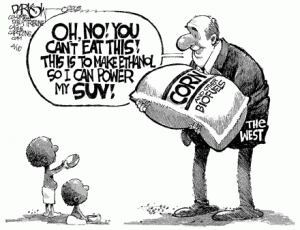
Fuel The World
Social and Enviromental Impact
Social Issue
One of the biggest concerns for biofuel is the dilemma of should crops be used for fuel production or as food. This debate is often referred to as the “Food vs. Fuel” debate and it mainly focused on the first generation biofuel which uses food crops such as corn and sugar cane as feedstock. At the same time the debate also include the second and third generation biofuels that may take up farmland to grow the biomass. Since the feedstock must be grown they inevitably take up space and especially for first generation biofuel that must take up arable land. The energy crops also compete with food crops for investment, water, fertilizer and labor. The side believing that biofuel production has great influence in food shortages supports their claim with the percentage of crops used for biofuel production and the global food price crisis in 2007-2008. As in 2007, around 25 percent of total corn production in the United States is used for ethanol production and the case is similar to many other countries pushing for biofuel. The food shortage can also be caused by the increase in food price as planting feedstock for biofuel is more profitable so farmers divert the land to plant energy crops. This side argues that as around 7 billion people in the world are already short on food, biofuel production should be postponed or reduced. However, the other side present that the biofuel production only contributes little to the food shortage as there are many other factors such as food distribution and population growth involved as well. Currently we have the most food per capita in history which is more than enough for all people around the world. The myth of our “food shortage” is simply due to scarcity and overpopulation. In addition, there are many unused arable farmland that is not used as it is not profitable for food production.
[45][46]

(41)

(42)
Environmental Issue
Biofuel production also poses threats of losing biodiversity, causing soil erosion and deforestation, and destroying local habitat. First of all, because growing large quantity of single crop is cheaper and easier energy crops are often grown in monoculture fashion. This reduces biodiversity and has the threat of having the large part of the plant to be wiped out when there is pest. Next, mature trees that are better at removing carbon dioxide than most energy crops are being cut down for land to plant energy crops causing deforestation and soil erosion. One example of the deforestation from biofuel production is the 9.4 million acres of forest in Indonesia that is cleared out to plant oil palm since 1966. This destroyed the habitat for many wild animals in Indonesia.

[47]
(43)
Economic Impact
Biofuel as a relatively new industry brings significant economic impact. The global production of biofuel increases by almost 150% from 2004 to 2010 with production of biofuel increased from 42 to 104 million liters. The number of jobs created directly by advance biofuel production is around 29,000 at 2012 and an estimate of 94,000 jobs by 2016 and 190,000 by 2022. Investments in advanced biofuels processing plants would reach to $8.5 billion in 2016 and $12.2 billion by 2022, Cumulatinge an estimate of more than $95 billion of investment in new processing facilities between 2009 and 2022. Other direct economic output from advanced biofuel industry includes capital investment, research and development, technology royalties, processing operations, feedstock production and biofuels distribution. These economic activities will reach approximately $37 billion by 2022. While the biofuel industry will generate these positive economic activities, the boosting biofuel industry may cause higher food price because of the new land allocation for biomass. The prices for corn and other major grains could rise by up to 3 percent and sugar by up to 8 percent.
[48]


